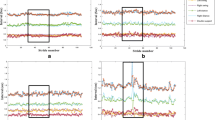Abstract
Neurodegenerative disorders (NDD) are a set of illnesses marked by the gradual degradation in the functioning of the central or peripheral nervous system. In recent works, aberrant gait patterns have been explored for detecting NDD like Huntington’s disease (HD), Amyotrophic lateral sclerosis (ALS), and Parkinson’s disease (PD) using quantitative evaluation techniques. In this study, we present a three-step automated technique for identifying ALS, PD, and HD subjects using their gait patterns. The first step is to examine the suitability of various time-domain statistical features extracted from the gait rhythm data for the identification of the disorders, the second step involves identifying the most favorable features, and finally, the third step is to test different machine learning classifiers to achieve the best accuracy in distinguishing different NDD patients from control participants. Validation of the proposed algorithm’s efficacy was done by using the PhysioNet dataset available in the public domain which includes gait rhythm patterns for ALS, PD, HD, and control subjects. Using LOOCV (Leave one out cross-validation) for accessing the performance of different available classifiers, maximum accuracy obtained was \(96.55\%\) with Decision Tree (DT) for healthy subjects vs ALS, \(93.55\%\) with Support Vector Machine (SVM) for control objects (CO) vs PD, and \(94.44\%\) using kNN for CO vs HD.
Access this chapter
Tax calculation will be finalised at checkout
Purchases are for personal use only
Similar content being viewed by others
References
Bennasar M, Hicks YA, Clinch SP, Jones P, Holt C, Rosser A, Busse M (2018) Automated assessment of movement impairment in huntington’s disease. IEEE Trans Neural Syst Rehabil Eng 26(10):2062–2069
Bennasar M, Hicks Y, Clinch S, Jones P, Rosser A, Busse M, Holt C (2016) Huntington’s disease assessment using tri axis accelerometers. Procedia Comput Sci 96:1193–1201; Knowledge-Based and intelligent information and engineering systems: proceedings of the 20th international conference KES-2016
Cicirelli G, Impedovo D, Dentamaro V, Marani R, Pirlo G, D’Orazio TR (2022) Human gait analysis in neurodegenerative diseases: a review. IEEE J Biomed Health Inform 26(1):229–242. https://doi.org/10.1109/JBHI.2021.3092875
Daliri MR (2012) Automatic diagnosis of neuro-degenerative diseases using gait dynamics. Measurement 45(7):1729–1734
Dentamaro V, Impedovo D, Pirlo G (2020) Gait analysis for early neurodegenerative diseases classification through the kinematic theory of rapid human movements. IEEE Access 8:193966–193980. https://doi.org/10.1109/ACCESS.2020.3032202
Frenkel-Toledo S, Giladi N, Peretz C, Herman T, Gruendlinger L, Hausdorff J (2005) Effect of gait speed on gait rhythmicity in parkinson’s disease: variability of stride time and swing time respond differently. J Neuroeng Rehabil 2:23
Frenkel-Toledo S, Giladi N, Peretz C, Herman T, Gruendlinger L, Hausdorff J (2005) Treadmill walking as an external pacemaker to improve gait rhythm and stability in parkinson’s disease. Mov Disord 20:1109–1114
Ghaderyan P, Ghoreshi Beyrami SM (2020) Neurodegenerative diseases detection using distance metrics and sparse coding: a new perspective on gait symmetric features. Comput Biol Med 120:103736. https://doi.org/10.1016/j.compbiomed.2020.103736, https://www.sciencedirect.com/science/article/pii/S0010482520301189
Goldberger A, Amaral L, Glass L, Hausdorff JM, Ivanov P, Mark R, Mietus J, Moody G, Peng C, Stanley H (2000) Physiobank, physiotoolkit, and physionet: components of a new research resource for complex physiologic signals. Circulation 101(23):E215-20
Hausdorff JM, Lertratanakul A, Cudkowicz ME, Peterson AL, Kaliton D, Goldberger AL (2000) Dynamic markers of altered gait rhythm in amyotrophic lateral sclerosis. J Appl Physiol 88(6):2045–2053
Hausdorff JM, Lowenthal J, Herman T, Gruendlinger L, Peretz C, Giladi N (2007) Rhythmic auditory stimulation modulates gait variability in parkinson’s disease. Eur J Neurosci 26(8):2369–2375
Mannini A, Trojaniello D, Cereatti A, Sabatini AM (2016) A machine learning framework for gait classification using inertial sensors: application to elderly, post-stroke and huntington’s disease patients. Sensors 16(1)
Mitchell TM (1997) Machine learning. McGraw-Hill, New York
Paula Felix J, Henrique Teles Vieira F, da Silva Vieira G, Augusto Pereira Franco R, Martins da Costa R, Lopes Salvini R (2019) An automatic method for identifying huntington’s disease using gait dynamics. In: 2019 IEEE 31st international conference on tools with artificial intelligence (ICTAI), pp 1659–1663
Saadeh W, Bin Altaf MA, Butt SA (2017) A wearable neuro-degenerative diseases detection system based on gait dynamics. In: 2017 IFIP/IEEE international conference on very large scale integration (VLSI-SoC), pp 1–6
Saljuqi M, Ghaderyan P (2021) A novel method based on matching pursuit decomposition of gait signals for parkinson’s disease, amyotrophic lateral sclerosis and huntington’s disease detection. Neurosci Lett 761:136107
Vajiha Begum SA, Rani MP (2020) Recognition of neurodegenerative diseases with gait patterns using double feature extraction methods. In: 2020 4th international conference on intelligent computing and control systems (ICICCS), pp 332–338. https://doi.org/10.1109/ICICCS48265.2020.9120920
Wahid F, Begg RK, Hass CJ, Halgamuge S, Ackland DC (2015) Classification of parkinson’s disease gait using spatial-temporal gait features. IEEE J Biomed Health Inform 19(6):1794–1802
Xia Y, Gao Q, Ye Q (2015) Classification of gait rhythm signals between patients with neuro-degenerative diseases and normal subjects: Experiments with statistical features and different classification models. Biomed Signal Process Control 18:254–262
Zeng W, Liu F, Wang Q, Wang Y, Ma L, Zhang Y (2016) Parkinson’s disease classification using gait analysis via deterministic learning. Neurosci Lett 633:268–278
Author information
Authors and Affiliations
Corresponding author
Editor information
Editors and Affiliations
Rights and permissions
Copyright information
© 2023 The Author(s), under exclusive license to Springer Nature Singapore Pte Ltd.
About this paper
Cite this paper
Tengshe, R., Singh, A., Raj, P., Yadav, S., Fathima, S.K., Fatimah, B. (2023). Automated Algorithm for Neurodegenerative Disorder Detection Using Gait-Based Features. In: Shakya, S., Balas, V.E., Haoxiang, W. (eds) Proceedings of Third International Conference on Sustainable Expert Systems . Lecture Notes in Networks and Systems, vol 587. Springer, Singapore. https://doi.org/10.1007/978-981-19-7874-6_19
Download citation
DOI: https://doi.org/10.1007/978-981-19-7874-6_19
Published:
Publisher Name: Springer, Singapore
Print ISBN: 978-981-19-7873-9
Online ISBN: 978-981-19-7874-6
eBook Packages: Intelligent Technologies and RoboticsIntelligent Technologies and Robotics (R0)




